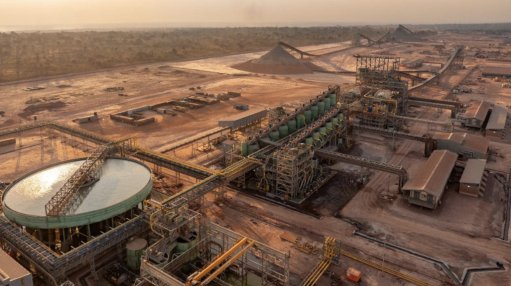
Kamoa-Kakula
TSX- and OTCQX-listed Ivanhoe Mines has reported that its Kamoa-Kakula Copper Complex in the Democratic Republic of Congo (DRC) produced 100 812 t of copper in concentrate during the second quarter and 186 925 t of copper in the first half of the year.
The company said on July 8 that Kamoa-Kakula’s Phase 3 concentrator was expected to ramp up to steady-state production in the third quarter, increasing yearly copper production capacity to more than 600 000 t.
As such, Ivanhoe has maintained its full-year production guidance for Kamoa-Kakula at between 440 000 t and 490 000 t of copper in concentrate.
Kamoa-Kakula's Phase 1 and 2 concentrators milled about 2.3-million tonnes of ore during the second quarter at an average feed grade of 5.3% copper.
Copper production from the Phase 1 and 2 concentrators was 99 706 t during the quarter, at an average flotation recovery rate of 87%, exceeding the Phase 1 and 2 concentrator design recovery rate of 86%.
Kamoa-Kakula’s Phase 3 concentrator, which was recently completed months ahead of schedule, produced its first concentrate on June 10 and is undergoing the completion of hot commissioning. Since then, the Phase 3 concentrator has produced 1 100 t of copper in concentrate.
As of June 30, 4.82-million tonnes of ore at an average grade of 3.26% copper is stored in surface run-of-mine stockpiles at Kamoa-Kakula. This includes 2.31-million tonnes of ore at an average grade of 3.72% at Kakula and 2.51-million tonnes of ore at an average grade of 2.85% at Kamoa and Kansoko.
Ivanhoe said the stockpiled ore from the Kamoa and Kansoko mines contains more than 70 000 t of copper and is being used for the hot commissioning and ramp-up of the new Phase 3 concentrator.
STABILISING THE GRID
Ivanhoe added that Kamoa Copper was still working with DRC State-owned power company La Société Nationale d’Electricité to deliver solutions for the identified causes of instability experienced across the southern DRC’s grid infrastructure since late 2022.
The project work, funded by Kamoa Copper, started in March and is expected to be completed towards the latter part of next year. The funding is assigned to increasing transmission capacity and improving the reliability of the grid.
Ivanhoe noted that, compared with previous quarters, production and mining head grades notably increased in the second quarter owing to the improved stability of grid-supplied power. Improved grid stability allowed the underground crews to mine the higher-grade areas of the Kakula mine, which are less accessible when power is unstable owing to reduced underground water pumping availability.
Since mid-March, grid power to Kamoa-Kakula has been supplemented by imported power via the Zambian interconnector. Currently, 55 MW of power is being imported from Zambia and Mozambique. Subject to capacity availability, Kamoa-Kakula’s executive team is targeting up to 100 MW to be imported by year-end.
As a redundancy measure, Kamoa Copper’s engineering team is expanding on-site backup generation capacity to ensure there will be full on-site backup for the phase 1, 2 and 3 operations.
The company said that the on-site backup-power generation capacity was on schedule to increase to more than 200 MW by the end of the year. An additional 72 MW of new generation capacity has recently been delivered to site.
Installation and commissioning of the new generators is expected to be complete in early August, increasing the total on-site generation capacity to 135 MW.
Meanwhile, on July 4, Switzerland-based Trafigura and Angola-based ProMarks signed a memorandum of understanding (MoU) with the Angolan government to study the technical and economic viability of building a 2 000 MW high-voltage electricity interconnector – a high-voltage direct current transmission line – to export surplus green electricity to the DRC Copperbelt and Zambia.
The project would enable electricity generated by hydroelectric dams located in the north of Angola to be connected to the Southern Africa Power Pool.
Under the MoU, a joint venture will be formed between ProMarks and Trafigura to develop, finance, construct and operate the electricity interconnector.
The project is intended to be financed through a combination of equity capital and third-party debt. Planning, approvals and construction will take about four years after the final investment decision is made.